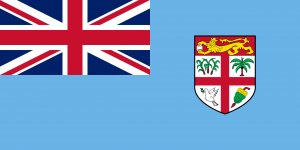Language/Fijian/Vocabulary/Money-and-Currency
| ◀️ Shopping Vocabulary — Previous Lesson |
In this lesson, we will learn the Fijian words for money and currency. Money is an essential part of our daily lives, and it is important to be able to communicate about it in any language. By the end of this lesson, you will be able to confidently talk about money and currency in Fijian, including using words like 'dollar', 'cent', 'coin', and 'banknote'. We will also practice using these words in sentences and questions to reinforce your understanding and help you become more fluent in Fijian.
Fijian Vocabulary for Money and Currency[edit | edit source]
Let's start by learning some basic vocabulary related to money and currency in Fijian. Here are the key words you need to know:
| Fijian | Pronunciation | English Translation |
|---|---|---|
| dola | doh-lah | dollar |
| seniti | sen-ee-tee | cent |
| sikoni | see-koh-nee | coin |
| bilokasi | bee-loh-kah-see | banknote |
Now let's practice using these words in sentences.
Practice Sentences[edit | edit source]
1. I have five dollars. Au sa tu na lima na dola. 2. How much is this shirt? E vica na dola na sulu oqo? 3. Do you have any coins? Sa moce na sauma? 4. Can I pay with a banknote? Au rawa ni sauma kei na bilokasi? 5. The price is twenty cents. Na kena vakarau e rua na seniti.
Now let's move on to some questions about money and currency.
Practice Questions[edit | edit source]
1. How much does it cost? E vica na kena vakarau? 2. Do you accept credit cards? Sa rawa ni vakabulai ki na kaadiki? 3. Can I get change, please? Au rawa ni kauta na kena voce, vinaka? 4. Where is the nearest ATM? Sa tu vei na ATM ni sa yakavi? 5. What is the exchange rate? Na kena vakarau ni vuli?
Great job! You are now familiar with the Fijian vocabulary for money and currency, and you can confidently use these words in sentences and questions. Keep practicing and using them in real-life situations to improve your fluency.
Cultural Insight[edit | edit source]
In Fiji, the official currency is the Fijian dollar (dola). The Fijian dollar is divided into cents (seniti), with coins available in denominations of 5, 10, 20, and 50 cents. Banknotes (bilokasi) come in denominations of 5, 10, 20, 50, and 100 dollars. It's important to note that while many businesses in Fiji accept credit cards, it is always a good idea to carry some cash with you, especially when visiting smaller towns or rural areas.
Fiji's currency reflects its cultural diversity and history. The use of the word "dola" for dollar comes from the influence of the English language, which is one of the official languages of Fiji. The Fijian dollar has been in circulation since 1969 when Fiji gained independence from British colonial rule. Before the Fijian dollar, the currency used was the Fijian pound, which was introduced during British colonial times.
When shopping or handling money in Fiji, it is customary to be polite and respectful. Use "vinaka" (thank you) when receiving change or completing a transaction, and remember to greet shopkeepers and others with a friendly "bula" (hello) or "sota tale" (goodbye) when leaving.
Exercises[edit | edit source]
Now it's time for some exercises to test your understanding of the Fijian vocabulary for money and currency. Translate the following sentences from English to Fijian:
1. The price is fifty dollars. 2. Do you have any coins? 3. How much does it cost? 4. Can I pay with a credit card? 5. Where is the nearest ATM?
Solutions: 1. Na kena vakarau e limasagavulu na dola. 2. Sa tu oqo e dua na sikoni? 3. E vica na kena vakarau? 4. Au rawa ni sauma kei na kaadiki? 5. Sa tu vei na ATM ni sa yakavi?
Explanation: 1. We use the number "limasagavulu" to represent "fifty" in Fijian. 2. "Sa tu oqo e dua na sikoni?" is the question form of "Do you have any coins?" 3. "E vica na kena vakarau?" is the question form of "How much does it cost?" 4. "Au rawa ni sauma kei na kaadiki?" is the question form of "Can I pay with a credit card?" 5. "Sa tu vei na ATM ni sa yakavi?" is the question form of "Where is the nearest ATM?"
Well done! You have completed the exercises successfully. Keep practicing and reviewing the vocabulary to reinforce your understanding.
Sources[edit | edit source]
Other Lessons[edit | edit source]
- Telling Time
- Express Surprise
- Health
- Shopping Vocabulary
- Education
- Ordering at a Restaurant
- How to Say Hello and Greetings
- Numbers 1 10
- Food
- Clothes
| ◀️ Shopping Vocabulary — Previous Lesson |

